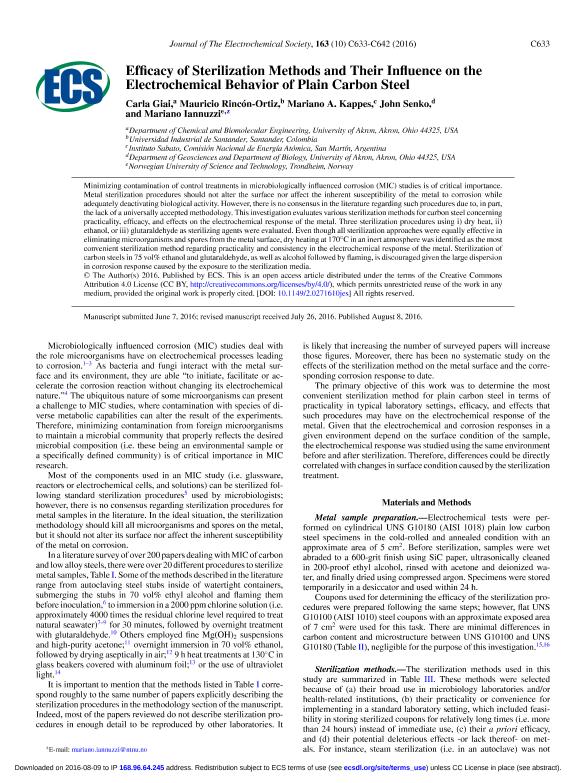Mostrar el registro sencillo del ítem
dc.contributor.author
Giai, Carla
dc.contributor.author
Rincón Ortiz, Mauricio

dc.contributor.author
Kappes, Mariano Alberto

dc.contributor.author
Senko, John
dc.contributor.author
Iannuzzi, Mariano

dc.date.available
2018-05-29T21:37:31Z
dc.date.issued
2016-08
dc.identifier.citation
Giai, Carla; Rincón Ortiz, Mauricio; Kappes, Mariano Alberto; Senko, John; Iannuzzi, Mariano; Efficacy of Sterilization Methods and Their Influence on the Electrochemical Behavior of Plain Carbon Steel; Electrochemical Society; Journal of the Electrochemical Society; 163; 10; 8-2016; C633-C642
dc.identifier.issn
0013-4651
dc.identifier.uri
http://hdl.handle.net/11336/46547
dc.description.abstract
Minimizing contamination of control treatments in microbiologically influenced corrosion (MIC) studies is of critical importance. Metal sterilization procedures should not alter the surface nor affect the inherent susceptibility of the metal to corrosion while adequately deactivating biological activity. However, there is no consensus in the literature regarding such procedures due to, in part, the lack of a universally accepted methodology. This investigation evaluates various sterilization methods for carbon steel concerning practicality, efficacy, and effects on the electrochemical response of the metal. Three sterilization procedures using i) dry heat, ii) ethanol, or iii) glutaraldehyde as sterilizing agents were evaluated. Even though all sterilization approaches were equally effective in eliminating microorganisms and spores from the metal surface, dry heating at 170°C in an inert atmosphere was identified as the most convenient sterilization method regarding practicality and consistency in the electrochemical response of the metal. Sterilization of carbon steels in 75 vol% ethanol and glutaraldehyde, as well as alcohol followed by flaming, is discouraged given the large dispersion in corrosion response caused by the exposure to the sterilization media.
dc.format
application/pdf
dc.language.iso
eng
dc.publisher
Electrochemical Society

dc.rights
info:eu-repo/semantics/openAccess
dc.rights.uri
https://creativecommons.org/licenses/by-nc-sa/2.5/ar/
dc.subject
Sterilization
dc.subject
Carbon Steel
dc.subject
Corrosion
dc.subject
Microbiologically Influenced Corrosion
dc.subject.classification
Físico-Química, Ciencia de los Polímeros, Electroquímica

dc.subject.classification
Ciencias Químicas

dc.subject.classification
CIENCIAS NATURALES Y EXACTAS

dc.title
Efficacy of Sterilization Methods and Their Influence on the Electrochemical Behavior of Plain Carbon Steel
dc.type
info:eu-repo/semantics/article
dc.type
info:ar-repo/semantics/artículo
dc.type
info:eu-repo/semantics/publishedVersion
dc.date.updated
2018-05-29T18:35:33Z
dc.journal.volume
163
dc.journal.number
10
dc.journal.pagination
C633-C642
dc.journal.pais
Estados Unidos

dc.description.fil
Fil: Giai, Carla. University of Akron; Estados Unidos
dc.description.fil
Fil: Rincón Ortiz, Mauricio. Universidad Industrial Santander; Colombia. Consejo Nacional de Investigaciones Científicas y Técnicas; Argentina
dc.description.fil
Fil: Kappes, Mariano Alberto. Universidad Nacional de San Martín. Instituto Sabato; Argentina. Consejo Nacional de Investigaciones Científicas y Técnicas; Argentina
dc.description.fil
Fil: Senko, John. University of Akron; Estados Unidos
dc.description.fil
Fil: Iannuzzi, Mariano. Norwegian University of Science and Technology; Noruega
dc.journal.title
Journal of the Electrochemical Society

dc.relation.alternativeid
info:eu-repo/semantics/altIdentifier/doi/https://dx.doi.org/10.1149/2.0271610jes
dc.relation.alternativeid
info:eu-repo/semantics/altIdentifier/url/http://jes.ecsdl.org/content/163/10/C633
Archivos asociados
